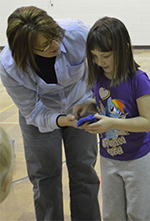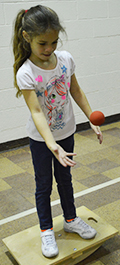East Kelloggsville Elementary School paraprofessional Joy Howard works with a student who has trouble tracking with his eyes and, as a result, difficulty completing his schoolwork.
So, before starting assignments when he meets with Howard, the boy exercises: tossing beanbags, standing on a moving balance board and bouncing a ball. The movements are part of the Bal-A-Vis-X curriculum, which uses movement in rhythm to stimulate the brain and get students using both sides of their brain.
After 10-12 minutes, “He says, I think I can write now’ and sits down and writes a whole page in organized prose,” Howard said.

“That was huge for me to see because it was instantaneous,” she said, recalling her first experience having the student try Bal-A-Vis-X. “He couldn’t write. He did the exercises and he could write.”
Mind-Body Connections
Kelloggsville educators are tapping into students’ responses to physical exercise with the curriculum, which stands for Balance, Auditory, Vision Exercises, to help them become better learners. Developed by educator Bill Hubert, the series of 300 exercises is done with sand-filled bags and racquetballs, often while standing on a balance board.
Howard and physical education teacher Connie Rietberg were trained to teach Bal-A-Vis-X by Brenda Munro, owner of Brains in Motion, a local company that offers training on movement-based programs that help students through brain development.
While Howard is using the technique in her academic support groups, Rietberg is using it in the gym: Her kindergarten and first-grade students regularly bounce balls while spelling and counting, balance on boards and complete various activities to get their brains and bodies working together.
 “Cognitive (brain) response and motor movement has always been something that works together. If one is lacking, more than likely the other is,” said Brenda Munro, owner of Brains in Motion. Munro, also a teacher at Innocademy, a school in Zeeland, and has studied optometry and vision therapy.
“Cognitive (brain) response and motor movement has always been something that works together. If one is lacking, more than likely the other is,” said Brenda Munro, owner of Brains in Motion. Munro, also a teacher at Innocademy, a school in Zeeland, and has studied optometry and vision therapy.
Schools are considering new ways to get students achieving at their highest potential, she said. There’s more awareness that physical movement is important in learning, but time constraints have led to less recess and physical education time. The stress and pressure of today’s high academic standards and lack of movement in everyday life can cause problems in school.
But there are ways to build the movements right into the school day, Munro said. Teaching students to focus on an activity based on rhythm can increase their ability to focus. Howard said other students she works with who struggle to settle down are able to focus after Bal-A-Vis-X.
“For a lot of kids who don’t know how to calm themselves, this might be the first time they have felt that calming effect,” Munro said.
For the students, it’s fun and challenging. In Rietberg’s gym class, first-grader Carlos Salcedo counted as he bounced a ball and balanced.
“One, two, three” he said, successfully reaching 14 before a missed catch. “Wow! I was at 14!”
CONNECT








